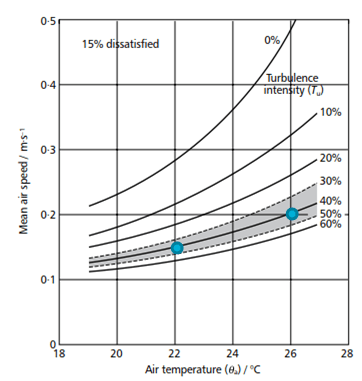Airtightness regulations in the UK
A brief overview of the most important building regulations on airtightness for builders and architects in the UK.
This is Part 1 covering UK energy efficiency & comfort regulations, UK Part 2 covers the risk of condensation & weathering, also for the UK. There is an ROI Part 1 and an ROI Part 2, too.

Everyone makes mistakes! That’s why we do not claim completeness, accuracy or liability. We are looking forward to your comment about suggestions for improvement!
Control of airtightness for energy efficiency & comfort – UK Regulations
Time and money are precious, especially so on a construction site. But as the saying goes, ‘act in haste, repent at leisure’. So, what do we absolutely have to do to ensure a robust building envelope? And, what are the advantages in going beyond that? This article is the first in a series of four which give a rundown of the key regulations and guidance in the UK and the ROI, as relevant to contractors.
Building regulations are law. And the Approved Documents are recognised means of complying with the regulation. There are four approved documents for Conservation of fuel and power in UK domestic & Non-domestic buildings. In the following, we summarise how the airtightness is regulated.
Good airtightness saves energy not only by reducing heat loss to draughts, but also by allowing the thermostat to be set lower.
Furthermore, an airtight building has demonstrated in practice a high level of build quality. This is a reassurance of genuine robustness, and surely something to be proud of.
Approved Document L1A: for new dwellings
Paragraph 0.3 requires an as-built EPC certificate to be produced & given to building control and the client prior to completion. The EPC is a standardised prediction of building efficiency & emissions. It is calculated for each individual dwelling and must meet national and local minimum performance standards, such as planning guidance.
The EPC result is strongly affected by the result of the airtightness test at handover, as described in paragraph 3.13. Poor performance in the test can mean that the building fails building control or fails to meet the contract requirements. This should be a very strong motivator to plan to meet, or improve on, this target. The air permeability of the building fabric (in m3hr/m2@50Pa) will have been entered into an early stage ‘DER or SAP’ calculation & will be in the building specification. This value is a mandatory requirement that you need to meet.
You must be aware of what that value is, and make a judgement of how difficult it is to achieve it for this dwelling. SIGA can help with this, for example by offering a design review, or training in how to best use SIGA products.
Typical values for air permeability
The unit of measurement is m3/hr/m2@50Pa. In words; ‘what is the total rate of air leakage (in m3/hr) divided by the total area of the external envelope (in m2), when the building is pressurised to 50 Pascals above ambient.
A high value means high permeability, ie poor performance.
| Maximum value (worst) | 10 |
| Typical for a new dwelling with trickle ventilation | 5 |
| Typical for a new dwelling with MVHR ventilation | <5 |
| Best practice, Passivhaus* | 1 to 2 |
* Be careful with units. Passivhaus specifications are often stated in Air Changes per Hour (ACH) at 50Pa. This is not the same and can be converted only if you know the building measurements.
What will come in the near future?
With NZEB requirement incoming for all new dwellings in 2025, and all new buildings by 2030, the fabric is going to need to meet best practice values.
| New buildings from 2025 1 to 2 | 1 to 2 |
Paragraphs 3.14-3.22 describe the testing procedure, which references ATTMA technical standard L1.
Planning for a successful as-built airtightness test starts in the early design and continues throughout construction right up until the test itself. We recommend to aim to exceed the target, to give yourself the best chance of meeting it.
There are numerous reasons for setting a much better target performance than the statutory maximum.
You receive guidance on effective U value of party walls
in NB Paragraph 3.7 . This is affected by edge sealing. The as-built construction should include sealing & insulation measures assumed by SAP calculation at design stage.
We summarise air & vapour control in the main types of wall & roof build ups in Part 2 of this article.
Approved Document L1B: For renovation of existing dwellings
Unless it is exempt, renovation work to all or part of a dwelling can trigger a requirement for improved building envelope performance. You may choose to demonstrate compliance via a whole building calculation method or via an elemental method. In Paragraph 4.6 the former is defined, similar to L1A. This calculation will include a design value for air permeability. So, for the whole building calculation method, this is the mandatory requirement that you need to meet.
Improving air tightness in an existing building is inherently less controlled and more risky than new build. It is something we will develop in later articles.
Paragraph 5.5 states that ‘reasonable provision should be made to reduce air leakage through new envelope parts’. Paragraph 5.6 refers to accredited construction details.
So, for the elemental method, this is the mandatory requirement that you need to meet.
It isn’t always possible or desirable to add excessive insulation or replace windows in historic or sensitive buildings. Improving on air tightness beyond the mandatory can be a cost-effective and low-impact way to make the building comfortable. So it is highly likely that you will be improving air tightness and adding insulation in places. The mandatory requirement described above is quite vague. If done incorrectly, especially with internal insulation, this can generate new risks for condensation.
Comfort & Airtightness
The comfort of the occupants is dependent not only on the room air temperature but also on the airspeed, as the work of Fanger showed.
The graph below shows the relationship between airspeed and comfort. For a given turbulence intensity of 40%, if the airspeed caused by draughts is, say, 0.15m/s, a 22°C temperature will be comfortable.

Own image, based on CIBSE A guide 2015
However, if the airtightness was worse, such that the airspeed is 0.2m/s, the thermostat will be raised to 26°C to remain as comfortable. In this way, draught-free rooms can be comfortable at lower temperatures.
And why is that important? Well, lower internal temperatures mean less overall heat loss from conduction through the envelope. And thus, with an airtight building, we can save more energy than from the reduction of the draughts alone. Pretty clever, we think.
Approved Document L2A: For new non-domestic
The principles and approach are very similar for L2A as for L1A. Unless exempt, the building must demonstrate through testing that it has achieved the design stage air permeability target. This is the mandatory requirement that you need to meet.
Paragraph 3.9. ATTMA method L2 describes the testing method.
Schools, swimming pools and archives are examples of non-domestic buildings which will require special attention to air tightness for efficiency or comfort.
Approved Document L2B: For renovation of non-domestic
As with L1B, unless the building is exempt, there are multiple ways to demonstrate compliance. If the whole building calculation method, defined in paragraph 4.9, is used then the performance defined in the SBEM calculation must be demonstrated by testing on site. This is the mandatory requirement that you need to meet.
Paragraphs 5.5-5.7 sets out the principles for construction to reduce condensation risk. See the accredited construction details here.
So, for the elemental method, complying with these is the mandatory requirement that you need to meet.
Summary
We have given a brief rundown of airtightness for efficiency regulation for the UK. If you are looking for guidance on vapour control and weathering, don’t miss the 2nd blog post about building regulations in the UK.
If you are planning to significantly exceed the regulations, as you probably are, take a look at the further resources listed below.
It doesn’t need to be difficult or risky but it will require timely planning & careful execution.
The route to success is the same for any building:
- Understand your target
- Plan for airtightness early on in the design- get help if you need it- SIGA can give advice to designers, run moisture modelling, and give training on site, too
- Communicate the design clearly to everyone on site
- Test the building as soon as the windows go in, but before internal linings are started
- Test it again before handover
And finally, any builder will tell you that money spent on easy-to-use products is a worthwhile investment.
Further guidance on building regulations in the UK
Most of these are aimed at Domestic, but the principles apply equally to Non-Domestic.
NHBC standards
- A basic checklist for airtightness is available from NHBC here.
- A practical guide to building airtight dwellings
But we stress that these documents describe the minimum work required. To achieve better than 10 m3/hr/m2@50Pa with confidence you must go significantly further.
The Builders Book
- This publication from the zero carbon hub gives useful advice on common errors & achieving better building quality. Free download it from here!
- The recent Design to Perform book takes this further
Passivhaus
- New build – Passivhaus Trust: How to build a Passivhaus
Renovation
- If you wish to go further in airtightness for renovations, refer to the EnerPhit standard
which sets the bar for robust & high performing retrofit.
What’s missing?
If you feel we’ve missed a critical piece of guidance, let us know in the comments.
Bertie Dixon
Bertie has practised building services engineering and sustainability consulting in the UK for 15 years. He is a certified PassivHaus planner. He is on a mission to help you deliver a high-quality building, one that does what it says on the tin.